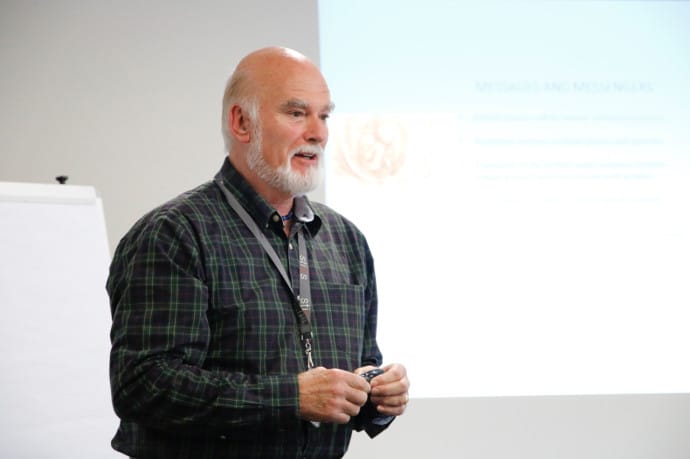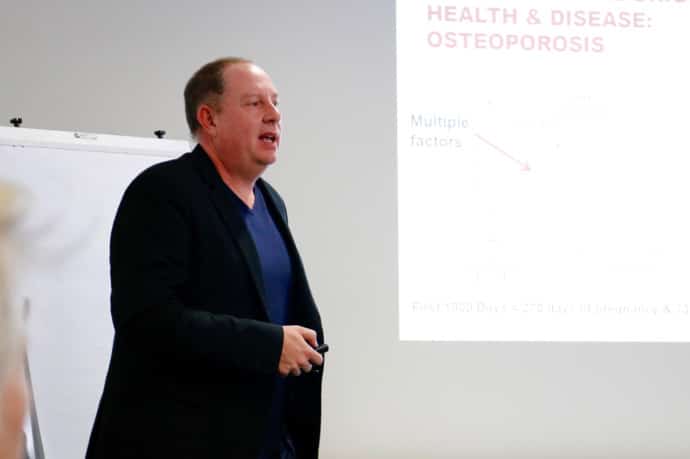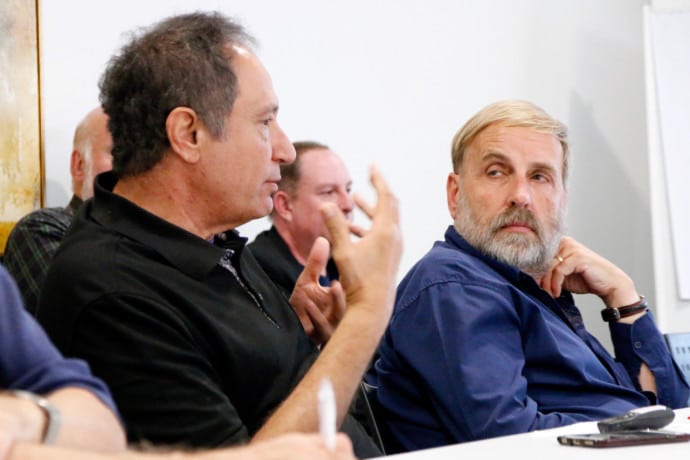“As a paediatrician I’ve spent a lifetime caring for sick and critically injured children. I realised many of these illnesses were preventable,” said Andrew Macnab of the Department of Paediatrics at the University of British Columbia. “The healthcare system in many lower and middle-income countries doesn’t have the resources to ‘fix’ things, we therefore have to focus on prevention and health promotion.”

Macnab was speaking at a seminar updating the work of the STIAS DOHaD group which was formed last year and falls under the long-term research theme Health in Transition. DOHaD – the Developmental Origins of Health and Disease – provides a paradigm for disease causation while also highlighting personal and population-level interventions for avoiding harm and promoting health. It’s based on growing evidence that many of the negative consequences of early childhood insults (including during pregnancy) are related to chronic non-communicable diseases (NCDs) in later life (including type-2 diabetes, cardiovascular diseases, some cancers and mental health).
The group also links their work with the United Nation’s Sustainable Development Goals many of which including #1 (eliminate poverty), #2 (eliminate hunger), #3 (good health, which mentions chronic non-communicable disease and also mental health) #4 (quality education), # 5 (gender equity), # 6 (clean water and sanitation) and #10 (reduced inequalities) are directly relatable to DOHaD activities.
In its first year the STIAS DOHaD group has had some substantial outputs. A 2016 workshop has led to a number of articles which will be published in a special Africa issue of the Journal of DOHaD; the initial steps have been taken to create an African Chapter of the DOHaD society; an influential paper aimed at policy makers has been published in Global Health Action (doi: 10.1080/16549716.2017.1334985); and, a 2017 Summer School is being organised with the African Academy of Sciences. This will bring together people with experience of translating evidence into policy as well as graduate students from all over Africa. There is also a book in early development.
“The DOHaD concept has been around for 50 years and initially focused on the foetal origins of disease and the first 1000 days of life but we are now realising this isn’t the only window for interventions and we are looking more at a life-course approach.” said Abdallah Daar, Convenor of the group and Professor at the Dalla Lana School of Public Health at the University of Toronto. “We also know that we can mitigate risks through interventions.”
Daar and Norris of the Developmental Pathways for Health Research Unit at the University of the Witwatersrand focused on diabetes as an example.
“More than 400 million people already have diabetes, and another 300 million are pre-diabetic,” said Daar. “By 2035 this will add up to about 1 billion people – the world will not be able to address the needs of so many.”
South Africa has seriously high levels of obesity with up to 67% of women estimated as being overweight or obese.
“Excess weight gain at any stage in the life cycle is linked to the increased incidence of type-2 diabetes,” said Norris.

However, the problem is especially worrying in young, pregnant women. “In South Africa 40% of women are overweight or obese by the age of 20 and 30% of women attending antenatal clinics are obese,” said Norris.
These young women are at high risk for gestational diabetes which increases their risk for immediate problems in delivery – including premature birth and post-partum bleeding – but also their risk for diabetes, heart disease and stroke in future. “However, this also puts the child at increased risk of metabolic problems and diabetes,” said Daar.
“We have to test pregnant women early and regularly for diabetes and take it seriously,” he continued. “We need to identify high-risk women for primary prevention to change both their life course and that of their children. We must also use all their interactions with the health services to improve their health literacy.”
“You are a product of what your grandmother ate,” added Norris. “Genetics don’t change but which genes get expressed do and you can change your risk trajectory for many NCDs.”
Norris also used the example of osteoporosis “which is a critical public health condition but the focus is only on elderly people once they start having fractures when very little can be done to reverse the condition. The skeleton is fully mineralised by the age of 25 to 30 – so to prevent the condition later in life you need to optimise peak bone mass at that age to change the risk trajectory.”
“But,” he said. “the clinical mindset is still often not geared enough to prevention.”
Translating evidence into practice
“We know how to prevent many of these NCDs,” added Daar, “with good food, increased exercise, not smoking and reducing excessive consumption of alcohol – it’s simple but we run into problems in practice. We need to translate the theory and push those interventions we know do work.”

And part of the challenge is the lack of concrete data and evidence from Africa to convince governments and the public. Often the only type of message that successfully reaches policy makers is a cost-benefit one.
“Ideally we want intergenerational data which doesn’t necessarily exist in Africa,” said Peter Byass of the Department of Public Health and Clinical Medicine at Umeå University. “However, if we know how common exposure is we can estimate how many people will develop the outcome and should be able to arrive at crude estimates for Africa which would be a powerful advocacy tool.”
Norris also pointed to a recently funded 10-year study to be undertaken in China, India, Canada and South Africa which will look at the impact of a nutritional intervention given to women pre-, during and post-pregnancy on the nutritional status of their children by age five.
“Studies like this this will move us towards much more concrete evidence,” he said. “Most of the evidence in DOHaD is at the population level – studies like this will give individual-level information which is very powerful.”
“However, the science will be empty unless it is translated,” cautioned Macnab. And translation includes ensuring the appropriate messages reach children giving them the information they need to set up a healthier life trajectory.
He pointed to very successful models to do this, like the World Health Organization’s for Health Promoting Schools. Macnab has conceived, deployed and evaluated several novel school-based projects in East Africa and the Far East during his eight-year association with STIAS. They are effective as “children are not small adults” he said.
“As adults we tend to know what we should do but choose not to change; but children process information differently and so what they learn in adolescence translates into the lifestyle choices and behaviours they adopt in their adult life.”
He highlighted education entertainment as a promising avenue to sow the seeds for behaviour change and showed a music video from Uganda which promoted the message of the need for early and ongoing antenatal care (https://youtu.be/10QCSdzZCKs). Music as well as other art forms like drama, dance and the visual arts appeal to the emotions, are culturally specific, and can therefore be a powerful tool for promoting behaviour change.
“Celebrity endorsed health promotion in music videos offers a powerful potential avenue to translate DOHaD for youth.” he said. “It’s about tapping into the charisma of heroes, heroines and role models, and utilising the appeal of social media.
“The Holy Grail is to get young people to listen, retain the messages and then change their behaviour,” he added. Youth want to have a voice and want to play their part in health promotion, and it is important our messages speak to youth of both genders.”
“It’s one child, one family and one community at a time but we have to make a start, and the evidence in the school yards of Africa is that positive messages in music videos are reaching a great many children.”
The STIAS DOHaD group will be aiming to do much more advocacy, to increase their multidisciplinary focus and to gather more evidence of what works. There are also plans for specific studies in the areas of food security, breastfeeding, Kangaroo care, the role of fathers and foetal alcohol syndrome.
Daar pointed out that messaging is truly important, but that there are also other policy-type interventions including direct approaches to governments, legislative approaches (e.g. laws aimed at reducing salt and sugar intakes at national levels), working with the World Health Organization to raise awareness, and also sensitising major research and innovation funding agencies to focus on early childhood development.
“Many people are talking about Universal Health Care nowadays: a DOHaD lens when planning this would be one of the best investments,” he concluded.
Michelle Galloway: Part-time media officer at STIAS
Photographs: Christoff Pauw
